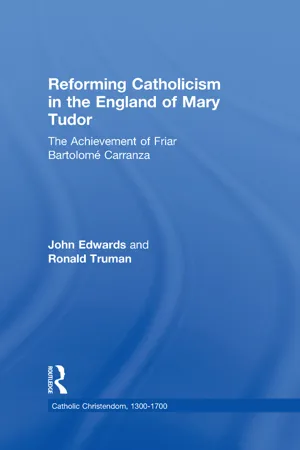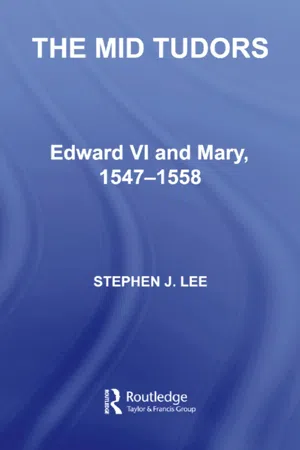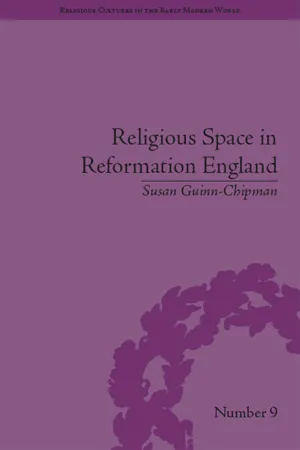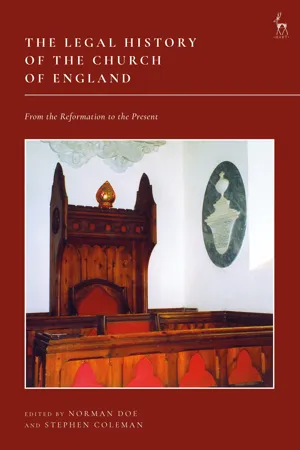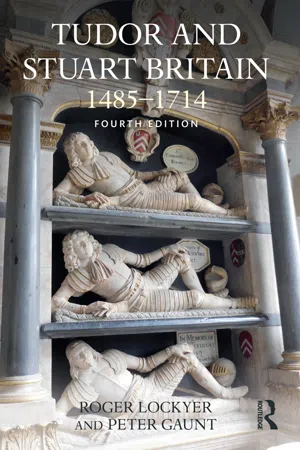History
Marian Restoration
The Marian Restoration refers to the period in English history from 1660 to 1688 when the Stuart monarchs, Charles II and James II, returned to the throne after the English Civil War and the Interregnum. This period marked the restoration of the monarchy and the Church of England after the republican Commonwealth and the rule of Oliver Cromwell. The Marian Restoration brought about significant political and religious changes in England.
Written by Perlego with AI-assistance
Related key terms
Related key terms
1 of 4
Related key terms
1 of 3
6 Key excerpts on "Marian Restoration"
- eBook - ePub
Reforming Catholicism in the England of Mary Tudor
The Achievement of Friar Bartolomé Carranza
- Ronald Truman, John Edwards, John Edwards(Authors)
- 2017(Publication Date)
- Routledge(Publisher)
CHAPTER 3 The Marian Restoration and the language of Catholic Reform Lucy WoodingThe reign of Mary Tudor was once easily classified: reactionary, repressive, misguided, unsuccessful. Nowhere was this description held to be more true than when applied to her religious policy.1 But more recent research, which has brought a very welcome challenge to these views, has left us with a far more complicated task when trying to understand the assumptions, expectations, and motivations behind the religious policy of the Marian Restoration.2 The present chapter will approach this hazardous undertaking through the medium of the religious literature published in the English vernacular during Mary’s reign. It will argue that the language of much of this literature provides an important indication of some of the preoccupations of the reign. There were, of course, variations among the works published between 1553 and 1558, and yet a great many of them used what might be termed the ‘language of Catholic reform’. The suggestion here is that such language had become an established aspect of English Catholic identity by the 1550s, and that it deployed a rhetoric which was firmly rooted in Scripture, open to the Augustinian and Pauline emphases beloved of Catholic as well as Protestant reformers, and fully aware of the need for religious regeneration within the Church.It will immediately become clear from comparison with other views expressed in this volume that this interpretation is a contentious one.3 It should perhaps be seen as part of a wider debate concerning the onset of confession-alization in England. For some, Catholic identity is a given, to a large extent an immutable expression of a clearly defined tradition. Discussion of sixteenth-century Catholicism, it could therefore be claimed, has a reasonably unequivocal standard of Catholic orthodoxy against which religious statements of the time can be measured. Conversely, it could also be argued that such an approach is deeply misleading, imposing a false coherence on an age when religious belief and identity were subject to as much change as continuity.4 - eBook - ePub
The People and the Book
Negotiating Religious Change in Reformation England and Beyond
- Caroline Litzenberger(Author)
- 2022(Publication Date)
- Cascade Books(Publisher)
Mary’s accession was the result of the failed attempts, over the previous twenty-five years, to save the realm from a female ruler. Mary was thirty-seven and unmarried. Her reign has been maligned for the way it tried to restore Catholicism. Some historians have labeled her “Bloody Mary” for her prosecution of Protestants as heretics and have suggested that all that bloodletting was for naught. However, she inherited some daunting challenges. These included an economic downturn, bad harvests, and the worst epidemic (influenza) since the Black Death in the fourteenth century. All this was in addition to her desire to return Catholicism to England. Her administration of her realm was, in fact, sound and her financial policies sensible in the face of the ongoing economic struggles the country was dealing with. She also took a methodical approach to returning Catholicism to England that could have succeeded. However, she did not have time to complete this process.Marian Catholicism was all about boundaries: boundaries between acceptable Catholic beliefs and those deemed unacceptable or heretical. Motivated in part by her intense personal piety, Mary and her bishops moved swiftly to implement the restoration of a form of Catholicism to England. At first her policy seemed quite simple: restore the Mass and the other elements of traditional liturgy, including the worship space, to the way they were at the time of Henry VIII’s death. This policy was introduced in a Royal Proclamation issued on August 18 , 1553 . This Proclamation, accompanied by a set of Injunctions, inhibited preaching, condemned the use of “newfound” terms, such as “papist” and “heretic,” and predicted that a religious settlement would be worked out “by common consent.” It also declared that priests would once again wear colorful vestments and the altar would be returned to the east wall above the level of the congregation. The rood loft with its “rood” or crucifix, flanked by statues of Mary and John, would once again fill the chancel arch. These injunctions also specified that choir voices would again fill the whole church with beautiful music during the Mass, and that parishioners would be surrounded by familiar images, like crucifixes and images of the Blessed Virgin Mary. (If a person had sung in the church choir in Edward’s reign, when the service was in English, they were required to remain in the choir during Mary’s reign, when the service was in Latin.)39 - eBook - ePub
The Mid Tudors
Edward VI and Mary, 1547–1558
- Stephen J. Lee(Author)
- 2006(Publication Date)
- Routledge(Publisher)
This has several strands. First, her initial religious policies were actually in keeping with a substantial part of public opinion. According to C. Haigh, ‘The reign of Mary saw a vigorous and quite imaginative programme of restoration, and, despite difficulties, the prospects for an established Catholic Church seemed good.’ 3 D. Loades agreed that there was at first very little resistance from the population at large. It had never been particularly enthusiastic about the spread of Protestantism during the previous reign. This had been pointed out by Martin Bucer, the continental reformer from Basle, who had written to Calvin in 1550: ‘Affairs in this country are in a very feeble state; the people are in want of teachers. Things are for the most part carried out by means of ordinances, which the majority obey very grudgingly and by the removal of the instruments of ancient superstition.’ 4 Given the incomplete nature of liturgical changes under Henry VIII and Edward VI, there was therefore a much better chance of restoring Catholicism under Mary. According to R. Hutton, ‘Accounts survive from 13 parishes. . . and show a considerable homogeneity in the process of Catholic restoration.’ 5 This involved restoring high altars, vestments, utensils, statues, ornaments and books. Many parishes even went beyond the legal requirements in their embellishments, indicating a popular enthusiasm denied by the more traditional interpretation. Of course, none of this can deny the simple fact that Mary eventually failed in her attempt to reverse the English Reformation. This means that an important part of the revisionist case is to explain why failure occurred despite promising beginnings, thereby reversing the previous preoccupation with why failure was inevitable from the outset - eBook - ePub
Religious Space in Reformation England
Contesting the Past
- Susan Guinn-Chipman(Author)
- 2015(Publication Date)
- Routledge(Publisher)
3 REFRAMING THE PARISH CHURCH IN MARIAN AND ELIZABETHAN ENGLAND: CULTURAL ADAPTATION IN THE LATER SIXTEENTH CENTURYWriting Easter week of 1558, churchwardens Robert Bishop and Robert Lambert of St Michael the Archangel at Mere recorded ‘varyannce and Contencon’ among certain of the parishioners.1 Amid the rising tensions of the following autumn, with the death of ‘or sayd sou’aigne lady Quene Marye (who dyed the xvijth day of Nouembre in the sayd yere of or lorde 1558’ and the resulting ‘Alteracon of some p[ar]te of Relygyon’ as her sister Elizabeth took the throne, alterations in the parish church ceased.2 Bishop and Lambert had only recently seen to the restoration of the image of Saint Michael and to the amending of the rood loft during the preceding year.3 That contention arose among parishioners was hardly surprising. In little more than two decades, divergent Tudor alterations had generated sweeping changes to the English religious landscape. Upon Mary I’s accession on 19 July 1553, the Catholic Queen initiated a restoration of recently suppressed images, altars and intercessory institutions. Her early death and the accession of Elizabeth I just five years later brought an end to the Marian effort and signaled an Elizabethan revival of Protestant church interiors along Edwardian lines. The ‘varyannce and Contencon’ at Mere reflected an increasingly divided English community, with parishioners and clergy compelled to once again implement Crown alterations and to re-engage with questions over the orthodoxy of their own parish church interior and their places within it.4This chapter examines responses to first Marian, then Elizabethan, reforms and reversals and the degree to which each were marked by tension and resistance. Although compliance or acceptance of the authority of the state to implement reforms was the most common response to these most recent Tudor alterations, the religious and cultural control established through royal injunctions and diocesan visitations proved somewhat limited in its reach. A broad spectrum of resistance to change in the Dioceses of Salisbury (Wiltshire) and Chester (Cheshire, Lancashire and several parishes in eastern Flintshire) led to the formation of dissonant cultural geographies, as some English men and women found alternative means of retaining, reframing and altering elements of pre-Reformation material culture. - eBook - ePub
The Legal History of the Church of England
From the Reformation to the Present
- Norman Doe, Stephen Coleman, Norman Doe, Stephen Coleman(Authors)
- 2024(Publication Date)
- Hart Publishing(Publisher)
5 The Restoration and Re-Establishment: 1660–1701 RUSSELL SANDBERGThe year 1660 is often regarded as a turning-point in the history of English law.1 The Restoration of the monarchy is often depicted as a return to the ancient constitution of the realm. Gone were most of the prerogative courts set up by the Tudors; gone was the absolute monarchy of the early Stuarts; gone was the republican personal rule of the Commonwealth.2 Yet these periods had all left their mark. Moreover, the Restoration of the monarchy was actually the introduction of something new: a modified and long-lasting complex and largely unwritten constitutional compromise, whereby the royal prerogatives remained but within the context of what would eventually become a parliamentary democracy. However, it is important not to get ahead of ourselves. These developments took centuries to be achieved, and at times, after several steps one way, a couple were taken in another – or backwards. Institutions from the past did not fade but often slowly mutated to suit the new context. For instance, the Court of Chancery remained but became more legalistic, and a court of the people rather than one of royal whim, and eventually found itself in the common law system.3Indeed, talk of ‘the Restoration’ risks over-simplifying this period, especially in relation to the position of the Church of England. As might be expected given the constitutional, legal and political upheavals of the periods leading up to and during the Civil War and the Commonwealth, turning back the clock was easier said than done. Moreover, the religious posture of the State was itself still rather new, being imposed only in the Tudor period and undergoing significant shifts during that and the age of the early Stuarts. The country did not simply time-travel back to the time before Charles I’s execution. Legal fictions suggested that this was so. As we saw in chapter 4 , laws passed during the Commonwealth were simply deemed void since they had not received royal assent. As Maitland noted, after the Restoration, ‘no lawyer would have appealed to them as law, and no lawyer would do so at the present day: they have no place in our statute book’.4 Charles II’s reign was considered to begin de jure in 1649, as denoted in relation to statutes by the regnal years continuing numerically from before the Commonwealth without interruption. However, this was a mere legalistic fiction. As a matter of fact, there had been a disruption, and the upheaval was far from over. Indeed, as Richard Helmholz observes, following the Civil War it had ‘all come crashing down’, and what happened after the Restoration remains, relatively,5 - eBook - ePub
Tudor and Stuart Britain
1485-1714
- Roger Lockyer, Peter Gaunt(Authors)
- 2018(Publication Date)
- Routledge(Publisher)
Charles IIThe Restoration and Charles II in perspective
The legacies of the mid-seventeenth century and the depth and durability of the changes wrought during the 1640s and 1650s are not entirely clear and give rise to continuing historical debate. The traditional view suggests that there had been a demonstrable change in political and constitutional power away from the Crown and towards Parliament and that although the return of Stuart kingship in 1660 led to the reversal of some of the specific statutes and means by which this had been achieved, the overall shift in power nonetheless survived to shape a very different type of post-Restoration monarchy. Similarly, traditional accounts argue that, while the Church of England also returned in 1660 and in many ways appeared to be the same as the pre-war Church, in reality things had altered – the Restoration Church lacked the authority and hold over the whole English (and Welsh) population that the Church had possessed during much of the Elizabethan and early Stuart period and, moreover, after 1660 religion became less central to the lives of many people and religious intensity and passions began to recede in public life, it is argued. These views were challenged in the late twentieth century by historians who tended to see in these areas greater continuity between the pre-war and the post-Restoration eras and to argue that the Restoration Crown and Church exercised much the same powers and held much the same positions as their early Stuart predecessors and also that religion and the role of the state Church remained throughout the Restoration era a central, vital and passionate element of everyday life as well as of government and politics. At the same time, some also came to recognize more sharply the role of the wider ‘public sphere’ in Restoration political life and to emphasize how the effective broadening of the parliamentary franchise because of inflation, the greater accessibility of printed news – print culture flourished, despite the tight censorship theoretically reimposed shortly after the Restoration – and of forums, including the new coffee houses, where such news could be discussed, and the expansion of towns and thus of urban political life all led on to a more informed, engaged and politicized public, who needed to be courted, and an energized public opinion, which needed to be respected by the political elite.
Index pages curate the most relevant extracts from our library of academic textbooks. They’ve been created using an in-house natural language model (NLM), each adding context and meaning to key research topics.
Explore more topic indexes
Explore more topic indexes
1 of 6
Explore more topic indexes
1 of 4
